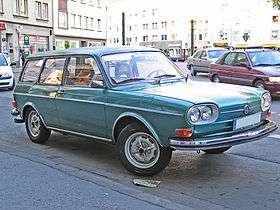Volkswagen Type 4
| Volkswagen 411 / Volkswagen 412 | |
|---|---|
 | |
| Overview | |
| Manufacturer | Volkswagen AG |
| Production |
1968-1972 (411) 1972–July 1974 (412) |
| Body and chassis | |
| Class | Mid-size / Large family car (D) |
| Body style |
2-door saloon 4-door saloon 3-door estate |
| Layout | RR layout |
| Related | Volkswagen Type 3 |
| Powertrain | |
| Engine |
1679 cc Flat-4 (411) 1795 cc Flat-4 (412) |
| Transmission |
4-speed manual 3-speed automatic optional |
| Dimensions | |
| Wheelbase | 2,500 mm (98 in)[1] |
| Length |
4,553 mm (179.3 in) (411) 4,583 mm (180.4 in)[1] (412) |
| Width | 1,675 mm (65.9 in)[1] |
| Height | 1,475 mm (58.1 in)[1] |
| Curb weight |
1,020 kg (2,250 lb) 2-door 411 1,120 kg (2,470 lb) Variant |
| Chronology | |
| Successor | Volkswagen Passat |
The Volkswagen Type 4 is a mid-sized car manufactured and marketed by Volkswagen of Germany from 1968 to 1974 in two-door and four-door sedan as well as two-door station wagon body styles. The Type 4 evolved through two generations, the 411 (1968–72) and 412 series (1972–74).
Designed under the direction of Heinrich Nordhoff and introduced at the Paris Motor Show in October 1968,[2] the 411 was Volkswagen's largest passenger vehicle with the company's largest engine – with styling credited to Carozzeria Pininfarina, who at the time had an advisory contract with Volkswagen.[3] The cars retained VW's trademark air-cooled, rear placement, rear-wheel drive, boxer engine with a front/rear weight distribution of 45/55%[3] and a forward cargo storage 400 l (14.1 cu ft)[4] — while also introducing design and engineering departures for the company – including a completely flat passenger area floor and suspension using control arms and MacPherson struts. Volkswagen had prototyped a notchback sedan version of the 411, without introducing it to production.
Over its six year production run, Volkswagen manufactured 367,728 Type 4 models, compared with 210,082 of the subsequent Volkswagen K70 with its four year model life. In the United States, VW sold 117,110 Type 4s from 1971 to July 1974. As Volkswagen's last air-cooled sedans and wagons, the Type 4 models were succeeded by the first generation Passat, marketed as the Dasher in the USA.
Features
As Volkswagen's first 4-door saloon, the Type 4 also introduced unibody construction, coil springs, trailing wishbone rear suspension, hydraulic clutch manual transmission – as well as MacPherson strut front suspension, subsequently adapted to the VW Type 1 1302/1303 ("Super Beetle").
The Type 4's battery was located under the driver's seat (passenger seat on RHD models). All models featured ventless driver and front passenger windows, notched on their leading edge to provide draught-free ventilation,[5] no cost metallic paint, radial ply tires, full carpeting, clock, electric rear window demister, flow-through ventilation, undercoating, and a thermostatically controlled auxiliary heating system,[4] specifically, a gasoline-operated heater model BA4 by Eberspächer, fired by a glow plug accessible from a hidden rear window deck plate.
When the Type 4 was discontinued in 1974, its engine carried on as the power plant for the larger-engined Volkswagen Type 2s, produced from 1972 to 1979, and for the later VW T25 1980–1983.
411

At launch, the 411 featured a 1679 cc engine with twin carburetors, subsequently modified in 1969 with Bosch D-Jetronic electronic fuel injection and claimed power output increased from 68 to 80 bhp (60 kW) — this fuel-injected engine shared with the mid-engined Porsche 914 also launched in 1969. European 411 nomenclature highlighted the fuel injection with the suffix 'E' (for Einspritzung). Revisions in 1969 also included replacement of the single oval headlights with twin round headlights.
The 411 was also assembled in South Africa beginning in 1969, in two- or four-door configurations. The four-door only came as a DeLuxe, with an optional automatic transmission, while the two-door was available either as a Standard or a DeLuxe.
412
The 412 replaced the 411 in August 1972[6] in Germany, having been restyled by designer Brooks Stevens.[1] Halogen lights were fitted,[6] the headlight surround was reshaped and the nose panels were redesigned. In 1974 the engine capacity was raised to 1795cc and fuel management reverted to a twin carburettor system, the 412LE now being renamed 412LS.
The visual design of the Volkswagen 412 Variant was followed when the Type 1 based Volkswagen Brasilia was produced in Brazil, primarily for the Latin American markets, and the Brazilian Type 3 models TL, Variant and Variant II.
In February 1974 on the German market the 4-door 412L was priced at DM 10,995 (DM 11,145 for the 412 LS).[1]
Data
| Technical data Volkswagen Type 4[7] (Manufacturer's figures except where stated) | ||||||
|---|---|---|---|---|---|---|
| Volkswagen 411 / 412 | 411 2- or 4-door saloon |
411 E/ LE 2- or 4-door saloon Variant (3-door estate) |
412 E/LE 2- or 4-door saloon Variant (3-door estate) |
412 2- or 4-door saloon Variant (3-door estate) |
412 S 2- or 4-door saloon | |
| Produced: | 1968–1969 | 1969–1972 | 1972–1973 | 1973–1974 | 1973–1974 | |
| Engine: | Four-stroke 4-cylinder boxer motor, rear-mounted | |||||
| Displacement: | 1679 cc | 1679 cc | 1679 cc | 1795 cc | 1795 cc | |
| Bore x Stroke: | 90 x 66 | 90 x 66 | 90 x 66 | 93 x 66 | 93 x 66 | |
| Max. Power @ rpm: | 68 hp (51 kW) @ 4500 | 80 hp (60 kW) @ 4900 | 80 hp (60 kW) @ 4900 | 75 hp (56 kW) @ 5000 | 85 hp (63 kW) @ 5000 | |
| Max. Torque @ rpm: | 124 N·m (91 lb·ft) @ 2800 | 132 N·m (97 lb·ft) @ 2700 | 132 N·m (97 lb·ft) @ 2700 | 129 N·m (95 lb·ft) @ 3400 | 135 N·m (100 lb·ft) @ 3400 | |
| Compression Ratio: | 7.8 : 1 | 8.2 : 1 | 8.2 : 1 | - | - | |
| Fuel feed: | Twin carburettors Solex 34 PDSIT | Electronic Fuel Injection Bosch D-Jetronic | Twin carburettors Solex 40 PDSIT | |||
| Fuel tank capacity: | 50 L (13.2 US gal; 11.0 imp gal) | |||||
| Valvetrain: | ||||||
| Cooling: | Air | |||||
| Gearbox: | 4-speed all-synchromesh manual with floor-mounted lever control & rear-wheel drive Optional 3-speed automatic | |||||
| Electrical system: | 12-volt | |||||
| Front suspension: | Independent. MacPherson Struts | |||||
| Rear suspension:: | Independent. Semi-trailing arms with double joint axles and coil springs | |||||
| Brakes: | Front discs / rear drums: Optional power assistance | |||||
| Steering: | Recirculating ball | |||||
| Body structure: | Monocoque | |||||
| Dry weight: | 1,020 kg (2,250 lb) - 1,080 kg (2,380 lb) ( 2-door) 1,040 kg (2,290 lb) - 1,100 kg (2,400 lb) ( 4-door) 1,120 kg (2,470 lb) ( Variant) | 1,080 kg (2,380 lb) ( 2-door) 1,100 kg (2,400 lb) ( 4-door) 1,120 kg (2,470 lb) ( Variant) | ||||
| Track front/ rear: | 1,376 mm (54.2 in) 1,342 mm (52.8 in) | 1,376 mm (54.2 in) 1,342 mm (52.8 in) | 1,386 mm (54.6 in) 1,350 mm (53 in) | 1,386 mm (54.6 in) 1,350 mm (53 in) | 1,386 mm (54.6 in) 1,350 mm (53 in) | |
| Wheelbase: | 2,500 mm (98 in) | |||||
| Length: | 4,553 mm (179.3 in) Saloon 4,525 mm (178.1 in) Variant | 4,583 mm (180.4 in) Saloon 4,555 mm (179.3 in) Variant | ||||
| Width: | 1,636 mm (64.4 in) | |||||
| Height: | 1,486 mm (58.5 in) | |||||
| Top Speeds ........Manual: ....Automatic: | 145 km/h (90 mph) 142 km/h (88 mph) | 155 km/h (96 mph) 152 km/h (94 mph) | 155 km/h (96 mph) 152 km/h (94 mph) | 150 km/h (93 mph) 147 km/h (91 mph) | 158 km/h (98 mph) 155 km/h (96 mph) | |
| Acceleration 0 – 100 km/h (0 - 62 mph) ........Manual: ....Automatic: | 18.0 s 21.0 s | 17.0 s 20.0 s | 17.0 s 20.0 s | 16.5 s 20.0 s | 14.5 s 17.5 s | |
Sources and further reading
- 1 2 3 4 5 6 "Test VW 412 LS". Auto Motor u. Sport. Vol. Heft 3 1974. 2 February 1974. pp. Seite 40–48.
- ↑ "News and Views: What's new at Paris". Autocar. Vol. 129 no. 3790. 3 October 1968. p. 59.
- 1 2 The Air-Cooled Era in Colour, Richard Copping, p. 168. Veloce Publishing, October 2005 (UK).
Long the subject of sneak preview photos, the VW 411 bore a passing resemblance to the VW 1600TL, while Pininfarina who had an advisory contract with Volkswagen, is credited with the car's styling.
- 1 2 "1971 Volkswagen 411, USA Brochure". Volkswagen.
- ↑ Dept of Transportation NHTSA Federal Motor Vehicle Safety Standards. Popular Mechanics, Bill Hartford, March 1971, p. 92.
- 1 2 "Neues vom Markt: Neuer 412: Sicherer, schoener und komfortabler". Auto Zeitung. Nbr 17 1972: Seite 4. 12 August 1972.
- ↑ Oswald, Werner (2003). Deutsche Autos 1945–1975, Band 4. Stuttgart: Motorbuch Verlag. pp. 62–65. ISBN 3-613-02116-1.
| Wikimedia Commons has media related to Volkswagen Type 4. |
| Volkswagen Passenger Cars, a marque of the Volkswagen Group, car timeline, European market, 1950–1979 — next » | ||||||||||||||||||||||||||||||||||
|---|---|---|---|---|---|---|---|---|---|---|---|---|---|---|---|---|---|---|---|---|---|---|---|---|---|---|---|---|---|---|---|---|---|---|
| Type | 1950s | 1960s | 1970s | |||||||||||||||||||||||||||||||
| 0 | 1 | 2 | 3 | 4 | 5 | 6 | 7 | 8 | 9 | 0 | 1 | 2 | 3 | 4 | 5 | 6 | 7 | 8 | 9 | 0 | 1 | 2 | 3 | 4 | 5 | 6 | 7 | 8 | 9 | |||||
| Economy car | Beetle (Type 1) | |||||||||||||||||||||||||||||||||
| Supermini | Polo I | |||||||||||||||||||||||||||||||||
| Derby I | ||||||||||||||||||||||||||||||||||
| Small family car | Type 3 | Golf I | ||||||||||||||||||||||||||||||||
| Large family car | Type 4 | |||||||||||||||||||||||||||||||||
| K70 (NSU) | Passat I | |||||||||||||||||||||||||||||||||
| Coupé | Karmann Ghia | Scirocco I | ||||||||||||||||||||||||||||||||
| Type 34 Karmann Ghia | VW-Porsche 914 | |||||||||||||||||||||||||||||||||
| Utility vehicle | Type 181 Kurierwagen/Trekker | |||||||||||||||||||||||||||||||||
| ||||||||||||||||||||||||||||||||||
| Volkswagen Passenger Cars, a marque of the Volkswagen Group, car timeline, North American market, 1950–1979 — next » | ||||||||||||||||||||||||||||||||||
|---|---|---|---|---|---|---|---|---|---|---|---|---|---|---|---|---|---|---|---|---|---|---|---|---|---|---|---|---|---|---|---|---|---|---|
| Type | 1950s | 1960s | 1970s | |||||||||||||||||||||||||||||||
| 0 | 1 | 2 | 3 | 4 | 5 | 6 | 7 | 8 | 9 | 0 | 1 | 2 | 3 | 4 | 5 | 6 | 7 | 8 | 9 | 0 | 1 | 2 | 3 | 4 | 5 | 6 | 7 | 8 | 9 | |||||
| Economy | Beetle (Type 1) | |||||||||||||||||||||||||||||||||
| Compact | Fastback / Squareback (Type 3) | Rabbit I | ||||||||||||||||||||||||||||||||
| Dasher | ||||||||||||||||||||||||||||||||||
| Mid-size | Type 4 | |||||||||||||||||||||||||||||||||
| K70 (NSU) | ||||||||||||||||||||||||||||||||||
| Coupé | Karmann Ghia | Scirocco I | ||||||||||||||||||||||||||||||||
| Convertible | Beetle Convertible | |||||||||||||||||||||||||||||||||
| Karmann Ghia Convertible | ||||||||||||||||||||||||||||||||||
| 181 Thing / Safari | ||||||||||||||||||||||||||||||||||
| Van | Microbus (Type 2 - T1) | Microbus (Type 2 - T2) | ||||||||||||||||||||||||||||||||
| ||||||||||||||||||||||||||||||||||
